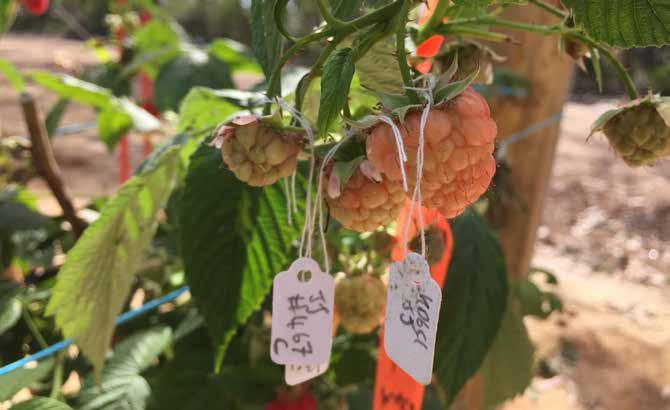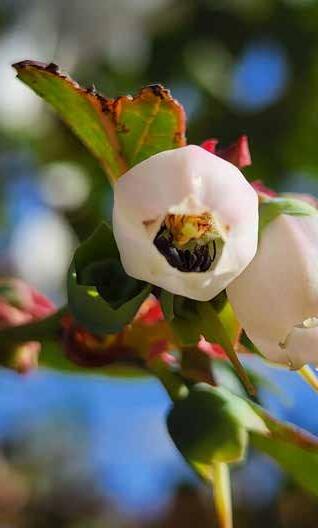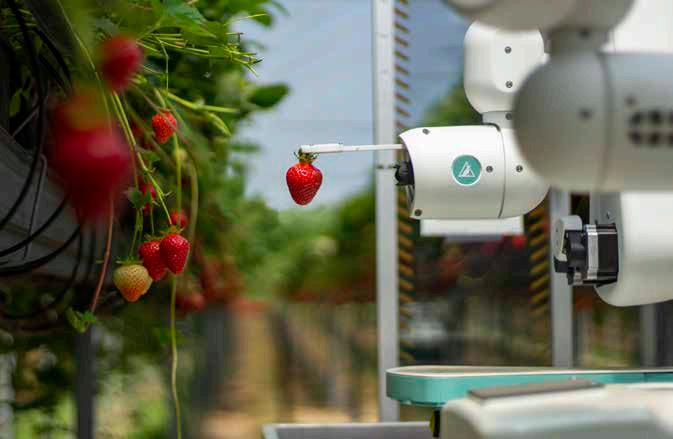
7 minute read
Better pollination knowledge can grow better berries
Romina Rader, Jeremy Jones, Karen C.B.S. Santos, Lena Schmidt, Jelena Preradovic, Blake Dawson, David J. Perović & Abby Davis - School of Environmental and Rural Sciences, University of New England
Maurizio Rocchetti, Jessica Scalzo & Bar Shermeister - Costa Group Exchange
Advertisement
Melissa Broussard, Brian Cutting & Lisa Evans - New Zealand Institute for Plant & Food Research
Crop and varietal data to better understand the importance of pollination (PH20001) is an investment in the Hort Frontiers Pollination Fund. Hort Frontiers is the strategic partnership initiative developed by Hort Innovation.
• The relationship between crop pollination, fruit quality, and yield is the result of the interaction between insect pollinator and crop plant biology
• The type of pollen transferred from an insect can vary in importance depending on how much the plant needs insects to move its pollen
• All crop cultivars exist somewhere along a gradient of low to high pollinator dependency
Berry growers across Australia all strive for abundant yields of high-quality berries, and insect pollination is an important component of crop production to achieve this goal. Crop pollination outcomes can be influenced by farm management practices and environmental variables, but fundamentally, the relationship between crop pollination, and subsequent fruit quality and yield is the result of the interaction between insect pollinators (e.g. bees, flies, ants) and crop plant biology.
The two key biological factors that drive this interaction are
(1) pollinator efficiency — a measure of an insect’s ability to transfer suitable pollen to a crop flower, and
(2) pollinator dependency — a measure of how much a crop type benefits from insect pollination for yield.
These two factors shape crop pollination outcomes in every orchard, which often have mixtures of crop types and insect pollinators. An understanding of these biological interactions between crops and pollinators is important for pollination management in berry horticulture, as these factors can inform many aspects of crop production, such as crop layout, cultivar co-plantings, pollinator selection, and hive density.
Insect pollinators can be introduced to crop fields to perform pollination services (e.g. managed honeybees) or naturally live within or near crop fields (e.g. wild hoverflies). Each type of insect pollinator, for example, honeybees, native bees or flies, has a unique set of features that influence their ability to transfer suitable pollen between flowers and pollinate a crop. These features may include body size, hairiness, and behaviour, among others.
Some insects (such as honeybees and Eristalis tenax flies) have large, hairy bodies, which provide a high surface area to carry pollen grains and are therefore very effective at moving pollen around, especially if they are attracted to crop flowers. Yet not all insects are attracted to all flowers and in particular, some are less attractive to particular pollinators, and this can impact their visitation rate.
Flies and other insects can also move pollen between crop flowers, and may sometimes they can pollinate more effectively in conditions where bees do not perform well, such as cold weather or intensive growing systems. Additionally, where the insect has been before it arrives at a crop flower is also important as it needs to be carrying berry pollen before it visits another berry, and some pollinators may vary in this behavioural trait. Most of the time, flowers receive a mix of different visits from different pollinators so the resulting pollen loads on the flower can be a complex mix of pollen from previous visits as a result of different insect behaviours.
Since pollination is an interaction, we also need to know how reliant the plant is on the insect. This is where pollinator dependency comes in.
The type of pollen transferred from an insect can vary in importance depending on how much the plant needs insects to move its pollen. Often, plants that are highly dependent on pollination by insects achieve the best yields and fruit quality when the pollen received is from a different cultivar (cross-pollination).
This is especially true for Rabbiteye blueberry varieties, which will often set few or very small fruit if they only receive pollen from their own cultivar. This means their pollinator dependency is HIGH, as pollen has to be transferred between plants of different cultivars.
Other blueberry cultivars, such as Snowchaser, still produce good yields without the pollen from other cultivars, but these plants require pollen to be moved by insects within or between flowers of the same plant (self-pollination), so their pollinator dependency is MEDIUM-HIGH.
Yet other cultivars, such as Arana, can produce a modest yield of large berries without any movement of pollen at all (parthenocarpy). These cultivars have a LOW pollinator dependency.
All berry crop cultivars exist somewhere along a gradient of low to high pollinator dependency, but most benefit from insect-mediated pollination.
To test where crop cultivars rank on the gradient of low to high pollinator dependency, experiments need to be conducted that compare the fruit set, fruit weight, or other fruit quality metrics. This is tested when flowers are bagged to exclude pollinators compared to when pollination is provided by insects or by hand.
Research into pollinator dependency of crops is important, as the level of pollinator dependence, and how it operates to affect yields, can have real management implications for crop production.

Field work identifying pollination in raspberries.
Photo credit: Jeremy Jones
For example, quantifying how much a crop benefits from cross-pollination can provide insights into how the crop field should be planted, which complementary cultivars are most suitable for cross-pollination, and how they should be arranged in rows to best facilitate the movement of pollen by insects.
Identifying which cultivars have low or high pollinator dependence may inform beehive stocking density and placement around farms to enhance insect pollinator activity where it is most needed.
Understanding which insects visit berry flowers under what conditions (e.g. low to high temperatures, under protective cropping covers, etc.), where they are collecting pollen from, and how to keep them happy in orchards, are also critical research questions for berry quality and yields.
There are some studies that show that a given number of flower visits is sufficient to meet the pollination requirements of a crop to form a perfect fruit. However, when you consider that this ‘number of visits’ value will differ for each cultivar and each insect pollinator species, the number of visits to produce a perfect fruit will also vary with insect activity at different temperatures and will change with whatever is flowering around the crop, there is still a lot of work to be done for future research to better understand all these factors in combination.
While we often assume we already know a lot about pollination, there is so much that is still unknown. Pollinator efficiency, response under different environmental and management conditions, and how they interact with other insects are all still important questions we need to consider.
As new cultivars are always being developed, we need to understand which cultivars perform best in which climates and planting arrangement and with which insects and management conditions.
More research concerning plants and the insects that visit their flowers will help to nurture beneficial insect activity in orchards and ensure our growing systems are resilient to future change in pollinator populations, climate and management system.

Stingless bee pollinating a blueberry flower.
Photo credit: Lena Schmidt
Acknowledgements
This research is supported by Horticulture Innovation Australia PH20001 Crop and varietal data to better understand the importance of pollination, a collaboration between Plant & Food Research, Griffith University, the University of New England and Western Sydney University.
Extra reading
Liam K. Kendall, Vesna Gagic, Lisa J. Evans, Brian T. Cutting, Jessica Scalzo, Yolanda Hanusch, Jeremy Jones, Maurizio Rocchetti, Carolyn Sonter, Matthew Keir, Romina Rader (2020). Self-compatible blueberry cultivars require fewer floral visits to maximize fruit production than a partially self-incompatible cultivar. Journal of Applied Ecology. Volume 57, Issue 12. https://doi.org/10.1111/1365-2664.13751
Mark A Hall, Jeremy Jones, Maurizio Rocchetti, Derek Wright, Romina Rader (2020). Bee Visitation and Fruit Quality in Berries Under Protected Cropping Vary Along the Length of Polytunnels. Journal of Economic Entomology, Volume 113, Issue 3, June 2020, Pages 1337–1346. https://doi.org/10.1093/jee/toaa037




